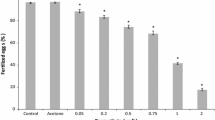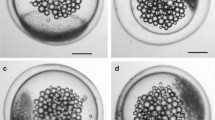Abstract
Fertilized eggs of the killifish,Fundulus heteroclitus, were exposed experimentally to methylmercury (MeHg) to evaluate whether this compound induced cytogenetic effects expressed in the embryos. An additional objective was to assess cytogenetically whetherFundulus embryos from groups that were determined to be more susceptible to the teratogenic effects of MeHg were also more susceptible to its mutagenic effects. Embryos exposed to 0.05 mg/L MeHg for 1 and 7 days post-fertilization were preserved in 10% formalin for cytological examination, while unfixed embryos from the same clutches were evaluated for teratogenic effects. Untreated embyros from each clutch served as controls. Cytogenetic-cytological analyses of fixed treated susceptible embryos that exhibited teratogenic effects revealed decreased mitotic counts (5.0-fold), and increased chromosomal aberrations (2.5-fold) when compared to their controls. There were also decreased mitotic counts (∼1.5-fold) and increased chromosomal aberrations (∼2-fold) in embryos from resistant groups when compared to their controls. Exposure to MeHg also retarded development. Forty to fifty percent of the susceptible and resistant control embryos reached the tail-bud stage, but only 28% of the treated resistant and none of the treated susceptible embryos reached this stage. There was also a significant correlation (P < 0.05) between teratogenic and mutagenic effects of MeHg in early stages ofFundulus.
Similar content being viewed by others
References
Al-Sabti K (1985) Frequency of chromosomal aberrations in the rainbow trout (Salmo gairdneri Rich.) exposed to five pollutants. J Fish Biol 26:13–19
Armstrong PB, Child JS (1965) Stages in the normal development ofFundulus heteroclitus. Biol Bull 128:143–168
Choi BH, Simpkins H (1986) Changes in the molecular structure of mouse fetal astrocyte nucleosomes producedin vitro by methylmercuric chloride. Environ Res 39:321–330
Dial NA (1978) Methylmercury: Some effects on embryogenesis in the Japanese medaka (Oiyzias latipes). Teratol 17:83–92
Harada M (1978) Methylmercury poisoning due to environmental contamination (“Minamata disease”). In: Oehme F (ed) Toxicity of heavy metals in the environment Part I. M Dekker, New York, pp 261–302
Jensen S, Jernelöv A (1969) Biological methylation of mercury in aquatic organisms. Nature 223:753–754
Kihlstrom JE, Lundberg C, Hulth L (1971) Number of eggs and young produced by zebrafishes (Brachydanio rerio Hamilton-Buchanan) spawning in water containing small amounts of phenylmercuric acetate. Environ Res 4:355–359
Kirsch-Volders ML, Verschaeve L, Susanne C (1983) Comparative effects of mercuric chloride on c-mitosis and acrocentric associations of mammalian cells. Mut Res 113:269
Klein DH, Goldberg ED (1970) Mercury in the marine environment. Environ Sci Technol 4(9):765–768
Longwell AC (1975) Mutagenicity of marine pollutants as it could be affecting inshore and offshore marine fisheries. Middle Atlantic Coastal Fisheries Center Informal Report No. 79. U.S. Dept of Commerce, National Oceanic & Atmospheric Admin, National Marine Fisheries Serv, Northeast Fisheries Center, Milford, CT, 72 pp
Longwell AC, Hughes JB (1980) Cytologie, cytogenetic, and developmental state of Atlantic mackerel eggs from sea surface waters of the New York Bight, and prospects for biological effects monitoring with ichthyoplankton. Rapp P-v Reun Cons int Explor Mer 179:275–291
Longwell AC (1981) Cytologic-cytogenetic perspectives on petroleum effects in the marine environment—chromosome aberrations. National Academy of Sciences background paper. Clearwater Beach, FL, 65 pp
Longwell AC, Perry D, Hughes J, Hebert A (1984) Embryological, cyto-pathological and cytogenetic analyses of '74, '77 and '78 planktonic Atlantic mackerel eggs in the New York Bight. Int Cons Explor Sea, Marine Environ Quality Comm E:13. Copenhagen, Den Statutory Meeting, 27 pp
McIntyre JD (1973) Toxicity of methylmercury for steelhead trout sperm. Bull Environ Contam Toxicol 9:98–99
Magee PN (1977) The relationship between mutagenesis, carcinogenesis and teratogenesis. In: Scott D, Bridges B, Sobels F (eds) Progress in genetic toxicology. Elsevier/N Holland Biomed Press, Amsterdam, pp 15–27
Onfeld A, Ramel C (1979) Some aspects of the organization of microfilaments and microtubules in relation to nondisjunction. Environ Health Persp 31:45–52
Ramel C (1969) Genetic effects of organic mercury compounds. I. Cytological investigations onAllium roots. Hereditas 61:208–230
— (1973) Monitoring of human populations. In: Evaluation of genetic risks of environmental chemicals. Royal Swedish Academy of Sciences, Goteborgs Offsettryckeri AB, Stockholm, Sweden, pp 17–21
Sadgopal A, Bonner J (1970) Proteins of interphase and metaphase chromosomes compared. Biochem Biophys Acta 207:227–239
Sharp JR, Neff JM (1982) The toxicity of mercuric chloride and methylmercuric chloride toFundulus heteroclitus embryos in relation to exposure conditions. Environ Biol Fish 7(3):227–284
Vogel DG, Margolis RL, Mottet NK (1985) The effects of methylmercury binding to microtubules. Toxicol Appl Pharmacol 80:473–486
Weis P, Weis JS (1977) Methylmercury teratogenesis in the killifish,Fundulus heteroclitus. Teratol 16:317–326
Weis JS, Weis P, Heber M, Vaidya S (1981) Methylmercury tolerance of killifish (Fundulus heteroclitus) from a polluted vs nonpolluted environment. Mar Biol 65:283–287
Weis JS, Weis P, Heber M (1982) Variation in response to methylmercury by killifish (Fundulus heteroclitus) embryos. In: Pearson J, Foster R, Bishop W (eds) Aquatic Toxicology and Hazard Assessment: Fifth Conference ASTM STP 766, Amer Soc for Testing and Materials, Philadelphia, PA, pp 109–119
Yunis JJ (1981) Chromosomes and cancer: New nomenclature and future directions. Human Pathol 12:494–503
Author information
Authors and Affiliations
Rights and permissions
About this article
Cite this article
Perry, D.M., Weis, J.S. & Weis, P. Cytogenetic effects of methylmercury in embryos of the killifish,Fundulus heteroclitus . Arch. Environ. Contam. Toxicol. 17, 569–574 (1988). https://doi.org/10.1007/BF01055824
Received:
Revised:
Issue Date:
DOI: https://doi.org/10.1007/BF01055824




